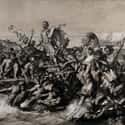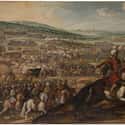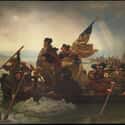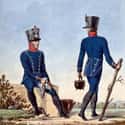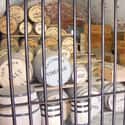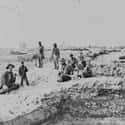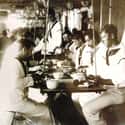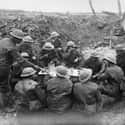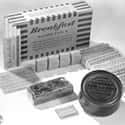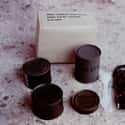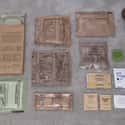-
(#1) Spartan Soldiers Drank Black Broth Made From Blood And Pigs' Legs
In ancient Greece, the Spartans built a culture dedicated to combat. Young boys moved into military barracks at age 7 to train. As Roman historian Plutarch explained, "Their training was calculated to make them obey commands well, endure hardships, and conquer..."
In a society dedicated to fighting, the Spartans didn't expect luxurious cuisine. In fact, Spartan soldiers ate black broth made from blood, boiled pigs' legs, and vinegar. Legend claims the soup was so disgusting that Spartans were willing to fall in combat to avoid eating it.
-
(#2) The Romans Relied On Carbohydrates And One Pound Of Meat Per Day
Rome built an army that dominated the ancient world. The army that conquered Europe, Africa, and the Near East benefitted from high-quality provisions. Rome's legions consumed fresh meat and luxurious foods like bacon, cheese, and wine.
Roman legions ate barley and wheat as staples of their diet. The army also consumed a pound of meat per soldier per day. To keep up with the high demand, Roman armies traveled with their own livestock, consuming 120 sheep a day.
The high-calorie diet helped the army cross continents to expand their empire.
-
(#3) The Crusaders Would Stop Mid-Fight To Start Eating Their Homemade Food
In 1095 CE, Pope Urban II called for the First Crusade. Over 100,000 Europeans responded, marching all the way to Jerusalem to retake the city.
In an era without standing armies, soldiers brought food with them. Crusaders probably ate dried meat and porridge, with fruit and cheese if they could afford it. Some soldiers even had to sell their possessions or mortgage their land to supply themselves.
Crusaders thought nothing of stopping mid-fight to eat. During the 1189-1191 CE siege of Acre, twice crusaders halted combat to eat, which helps to explain why it took two years to capture the city.
-
(#4) Genghis Khan’s Mongol Warriors Ate 'Saddle Stew'
Genghis Khan and his army conquered the largest land empire in history. With rations of dried milk curd, Mongol warriors managed to conquer territory equivalent to the size of the entire African continent.
The nomadic Mongols weren't farmers, they largely subsisted on their livestock. Mongols divided their diet into white foods and red foods. The white foods, or dairy, included fermented horse milk, while the red foods included meat.
Mongol warriors sometimes stuck a bag of meat, onions, and rice under their saddle while riding. The friction of a day's ride would cook the meat, turning it into a saddle stew. According to Marco Polo, warriors made small punctures in their horses' neck and drank their blood on long rides.
-
(#5) The Ottoman Empire Ate Fresh-Baked Bread And Honey
In 1683 CE, the Ottomans laid siege to Vienna, nearly capturing the city. Led by foot soldiers called the Janissary, the Ottomans benefitted from bountiful military rations. Ottoman soldiers consumed fresh-baked bread, a daily ration of lamb and mutton, and luxury items like honey and coffee.
When fresh bread wasn't available, soldiers ate biscuits that were cooked in Istanbul then shipped to the fights. In the 17th century, an observer recorded that 105 ovens in the capital city cooked biscuits for the troops. In fact, biscuits were so desired by the Ottoman Army that dishonest bakers would sometimes replace flour with dirt, taking the lives of several soldiers as a result.
-
(#6) George Washington’s Soldiers Would Survive Days Without A Single Ration During The American Revolution
During the American Revolution, George Washington's army had a major advantage - they were fighting on their own soil. In contrast, the British had to ship soldiers, munitions, and provisions overseas, but the continental army still faced major supply problems.
In 1775, Congress authorized a pound of beef and a pound of flour per day. Soldiers were also supposed to get peas or beans, milk, rice, beer or cider, and molasses. But without taxation authority, Congress couldn't afford the rations. As a result, soldiers often went days without rations.
Congress told General Washington to simply seize food, but he refused. Washington worried that taking provisions would quickly turn colonials against their army.
-
(#7) Napoleon’s Army Carried Baguettes In Their Pants
In 1812, Napoleon's infiltration of Russia failed spectacularly when thousands of soldiers starved. Napoleon began the march with 600,000 soldiers, but only 25,000 survived.
The incident proved Napoleon's own adage: “An army marches on its stomach.” At the time, the rations for French soldiers included 24 ounces of bread, half a pound of meat, and a quart of wine. French troops were so dedicated to bread that they brought along baguettes. The long, narrow shape allowed soldiers to carry the bread in their pant legs.
-
(#8) Union Soldiers Dined On Molasses, Dried Fruit, And Pork
During the Civil War, the Union army dined on meat, flour, and even dehydrated vegetables.
John Billings, a Union veteran, said the troops were given "salt pork, fresh beef, salt beef, rarely ham or bacon, hard bread, soft bread, potatoes, an occasional onion, flour, beans, split peas, rice, dried apples, dried peaches, desiccated vegetables, coffee, tea, sugar, molasses, vinegar, candles, soap, pepper, and salt."
In fact, molasses had been a standard US military ration since the American Revolution.
-
(#9) Cutting Rations Helped End The Confederacy
The Confederates struggled to feed their army. The lack of food was so bad that General Robert E. Lee warned that "desertions to the enemy are becoming more frequent." Lee added, "Unless there is a change, I fear the army cannot be kept together."
Confederate soldiers were forced to forage for food on the march. One soldier wrote in 1864, "[men got] a vegetable diet by cooking up polk, potato tops, May pop vines, kurlip weed, lambs quarter, thistle and a hundred kind of weeds... I thought it trash… but the boys call it ‘long forage.'"
-
(#10) Canned Foods In The Spanish-American War Felled More Soldiers Than The Fighting
American troops in the Spanish-American War were the first to receive canned food in their military rations, but the canning techniques were so bad that many soldiers faced food poisoning and even loss of life after eating the provisions.
Veteran Carl Sandburg said of the canned beef:
A tin of 'Red Horse' would be handed to one man who opened it. He put it to his nose, smelled of it, wrinkled up his face, and took a spit. The next man did the same and the next till the eight men of the mess had smelled, grimaced, and spit.
The men then threw the beef overboard, complaining it smelled like an embalmed cadaver.
Shockingly, botulism and other food-borne illnesses in the canned food may have taken more lives than combat. While only 280 Americans perished in combat, more than 2,600 passed from other causes.
-
(#11) Troops Ate 'Dog Biscuits' In WWI
American soldiers ate reserve ration during WWI. Designed for the long overseas voyage, the rations weren't known for their taste. Soldiers dined on canned meat and vegetables, hardtack crackers (which the troops called "dog biscuits"), tobacco, and candy.
Rations were not limited to cold foods, though, as men on the front lines sometimes ate hot meals cooked in milk cans.
-
(#12) WWII Soldiers Were Given Smokes And Chewing Gum
By WWII, the American army developed new rations. Designed to be light and easy to carry, the rations came in three forms: C-ration, D-ration, and K-ration.
C-ration and K-ration contained tinned beef and potatoes, biscuits, toffee, and instant coffee. It usually contained smokes and chewing gum, as well, along with toilet paper. One ration was supposed to last three meals and provided 3,600 calories.
The D-ration was simply a chocolate bar.
-
(#13) Vietnam Soldiers Had Malaria And Diarrhea Pills In Their Rations
During Vietnam, the military introduced MCIs, or Meal, Combat, Individual rations. The unpopular rations included canned meat, which soldiers heated up with C4. The troops also received cans of crackers, cookies, applesauce, and cake. On patrol, soldiers sometimes placed the cans in socks and tied them to their backpacks.
The rations also included a malaria tablet, salt pills, and Lomotil tablets, which soldiers took four times a day to control diarrhea.
-
(#14) Modern Day American Soldiers Can Choose Their Own Meals To Avoid 'Menu Fatigue'
The American army introduced a new ration in the 1980s called MREs (Meals, Ready to Eat). Instead of cans, soldiers received sealed bags containing food. MREs addressed complaints about previous rations by offering 24 different dishes, including kosher, halal, and vegetarian options.
In 2018, the army introduced MRE pizza, which can stay fresh for three years. Soldiers can order MRE No. 23, which contains pizza, breadsticks, blueberry cobbler, a chocolate protein drink, and a cookie.
New Random Displays Display All By Ranking
About This Tool
Military food culture is produced by the interaction between social food culture and military culture in the long-term military food security practice activities. Soldiers not only need food to survive, but they also need to maintain or strengthen their confidence through enough military rations. Food can also be an incentive for war or a subsidiary product of war, such as canned food. Over the centuries, the military rations in various periods have changed a lot.
You could find more information about the evolution of military rations throughout history on this page, the importance of military rations is self-evident. Few people know that spices also play an important role in military rations.
Our data comes from Ranker, If you want to participate in the ranking of items displayed on this page, please click here.












